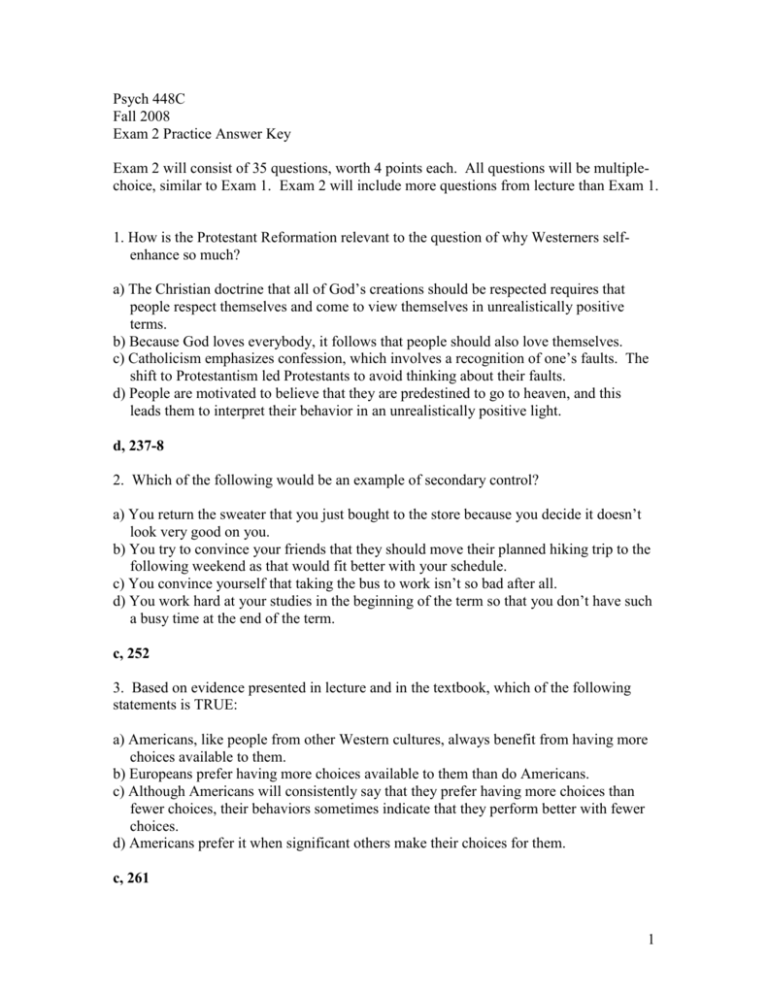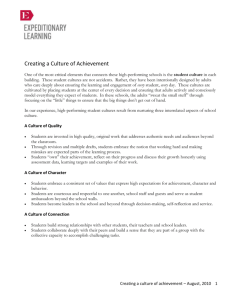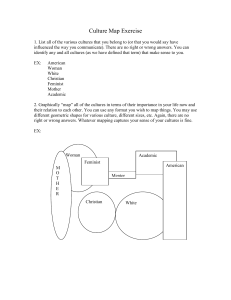Exam 2 Practice Answ..
advertisement

Psych 448C Fall 2008 Exam 2 Practice Answer Key Exam 2 will consist of 35 questions, worth 4 points each. All questions will be multiplechoice, similar to Exam 1. Exam 2 will include more questions from lecture than Exam 1. 1. How is the Protestant Reformation relevant to the question of why Westerners selfenhance so much? a) The Christian doctrine that all of God’s creations should be respected requires that people respect themselves and come to view themselves in unrealistically positive terms. b) Because God loves everybody, it follows that people should also love themselves. c) Catholicism emphasizes confession, which involves a recognition of one’s faults. The shift to Protestantism led Protestants to avoid thinking about their faults. d) People are motivated to believe that they are predestined to go to heaven, and this leads them to interpret their behavior in an unrealistically positive light. d, 237-8 2. Which of the following would be an example of secondary control? a) You return the sweater that you just bought to the store because you decide it doesn’t look very good on you. b) You try to convince your friends that they should move their planned hiking trip to the following weekend as that would fit better with your schedule. c) You convince yourself that taking the bus to work isn’t so bad after all. d) You work hard at your studies in the beginning of the term so that you don’t have such a busy time at the end of the term. c, 252 3. Based on evidence presented in lecture and in the textbook, which of the following statements is TRUE: a) Americans, like people from other Western cultures, always benefit from having more choices available to them. b) Europeans prefer having more choices available to them than do Americans. c) Although Americans will consistently say that they prefer having more choices than fewer choices, their behaviors sometimes indicate that they perform better with fewer choices. d) Americans prefer it when significant others make their choices for them. c, 261 1 4. Analytic thinking styles are a) especially common in East Asian cultures. b) largely limited to Western cultures. c) common in many cultures outside of the West. d) becoming less common over time. b, 359-361 5. Which of the following describes the results of a study investigating the relation of talking and thinking? a) East Asians perform worse on an IQ test when they think or reason out loud, but their performance is relatively unaffected when they recite the alphabet, a task that does not involve much reasoning. b) Westerners perform worse on an IQ test than East Asians, regardless of whether they out loud or recite the alphabet. c) Thinking out loud enhances the performance of East Asians on an IQ test. d) Reciting the alphabet enhances the performance of Westerners on an IQ test. a, 385-7 6. Anthropocentrism a) is a cultural universal. b) is something typical of children everywhere, although adults in some cultures no longer demonstrate it. c) is more common among children who do not grow up in proximity to many kinds of animals. d) is more common among holistic reasoners than among analytic reasoners. c, 404-5 7. Depression is a condition a) that has been found in every culture that has been explored. b) is largely absent in China. c) that is culture-bound mainly among Western, industrialized societies. d) that is found at similar rates in the population in all industrialized societies. a, 420 8. Higher suicide rates among Canadian First Nation youths a) appear to be largely the result of copy-cat suicides. b) have been steadily dropping over time. 2 c) are associated with their communities having few connections to their traditional past. d) are due to different cultural meanings of suicide. c, 428 9. The relation between income and health can be summarized as a) absolute income predicts health outcomes for low levels of income, whereas income relative to those around one predicts health outcomes for high levels of income. b) there is a linear relation between absolute income and health, but a curvilinear relation between relative income and health. c) income is largely unrelated to health once you control for dietary practices. d) the health of wealthy people is poor because of all the stress that they experience in positions of great responsibility. a, 448-9 10. Group-enhancing biases are a) more pronounced among East Asians than Westerners. b) more pronounced among Native-Americans than Euro-Americans. c) more pronounced among Westerners than East Asians. d) weaker than self-enhancing biases for people from all cultures. c, 235 11. Which of the following statements is true of “face.” a) People can increase their face by focusing on their positive qualities. b) all people have roughly the same amount of face. c) face is more easily lost than it is gained. d) face is negatively correlated with self-esteem. c, 240 12. When the motivation of Asian-American and Euro-American children to play a computerized math game called “Space Quest” was assessed, the results showed that: a) Asian-American children were more motivated to play the game than Euro-Americans if their classmates made some choices for them. b) Asian-American children were always more motivated to play the game than were Euro-American children. c) Asian-American children were more motivated to play the game if they made their own choices than if those choices were made by others. d) Euro-American children were more motivated to play the game if their classmates made choices for them than if an outgroup made choices for them. 3 a, 259-261 13. Working-class and upper middle-class Americans differ in that a) working class Americans are happier than upper middle-class Americans. b) although working class Americans do not have as many choices available to them, they desire choice, and respond to choices made by others, in the same way that uppermiddle class Americans do. c) upper middle-class Americans employ more primary control than do working-class Americans. d) upper middle-class Americans desire control less than do working-class Americans. c, 264-6 14. Which of the following statements about self-esteem is most accurate? a) there is very little variation in self-esteem across cultures. b) in interdependent cultures, interdependence is positively related to self-esteem, whereas in independent cultures, independence is positively related to self-esteem. c) independence is positively related to self-esteem. d) interdependence is positively related to self-esteem. c, 238 15. Color terms from different cultures around the world a) vary in arbitrary ways. b) are pretty much the same everywhere, with the exception of colors in the blue-green spectrum. c) vary in that some cultures only have color words for red and green, whereas other cultures only have color words for blue and yellow. d) all correspond to a small number of different possible sets of terms. d, 394 16. People from cultures that do not have words for numbers beyond 2 or 3 a) can still detect changes in the number of objects the same as those that have words for a complete number set. b) are unable to discriminate between different quanitities. c) are able to discriminate between rough proportions, but not for precise numbers. d) can still do basic counting, but not basic addition or subtraction. c, 403-4 4 17. Research on cultural differences in reasoning reveals that a) East Asians use analytic reasoning strategies in most math and science problems. b) Westerners are less likely to use analytic reasoning strategies than East Asians when there is a conflict between analytic and holistic solutions. c) East Asians are more likely than Westerners to reason on the basis of abstract rules. d) East Asians are unable to engage in analytic reasoning strategies. a, 376-7 18. When Chinese make predictions about the future based on what has happened in the past, compared to the predictions of North Americans they are a) consistently more pessimistic in their predictions. b) consistently more optimistic in their predictions. c) more fixated on the past patterns. d) less linear in their predictions. d, 382-3 19. In contrast to depressed people in North America, Chinese who are diagnosed with depression are a) less likely to report sleep complaints. b) less likely to report depressed mood. c) more likely to take anti-depressants. d) more likely to become suicidal. b, 421 20. The fact that people from some cultures lack an enzyme to allow them to digest milk reflects that a) cultural practices can affect human evolution. b) cultural practices are shaped by the local geography. c) people from different cultures differ more in terms of their genes than they do in terms of their cultural practices. d) there is no clear distinction between genetic evolution and cultural evolution. a, 434 5








